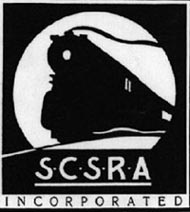
|
DEPARTMENTS
Intro to the SCSRA
|
Travel Town (continued)
Return to Page 4 | Page 5
October 10, 1954 marked the culmination of a project on the part of the Southern California Chapter of the Railway and Locomotive Historical Society, which had been in the making for nearly a year. Through the efforts of several of it's members, Mr. Walter H. Dillingham, president of the Oahu Railway and Land Co., of Hawaii, donated a complete narrow gauge train consisting of 4-6-0 locomotive 85, combination coach 36 and coach 1, together with an 0-6-2 saddle tank locomotive from the Oahu Sugar Company, a sugar cane car, and a caboose, all in 3 ft. gauge.
The Matson Navigation Co. transported all the equipment free from Honolulu to Los Angeles, and the ever faithful Belyea Truck Co. was right on the job to bring all six units from the harbor docks to Travel Town. A cleared area in the abandoned pumping station yard was used for storage of the narrow gauge equipment, which was presented to the city with suitable dedication ceremonies.
On February 10, 1955, the construction firm of Sharp and Fellows donated a 2-6-2, or prarie type locomotive, No. 7, which had been used on various construction jobs for nearly fifty years, but it had been standing outdoors for a very long time, out of service, and was in very poor condition. The Southern Pacific generously donated a complete steam cleaning, a new boiler jacket, plus a complete paint job, and it came into Travel Town looking as if it had just been turned out of the factory. Oh yes, Jack Belyea brought 7 over from Glendale - no trouble at all. While No. 7 has no glamorous history of mainline passenger service, it is easily one of the handsomest locomotives in the pard, and a fine example of Dickson design during it's first year under the Alco banner in 1902.
On July 15, 1955, a shay geared engine was donated by the Michigan-California Lumber Company., this having been Camino, Placerville and Lake Tahoe No. 2, built in 1921. Again the Southern Pacific and Belyea provided free transportation, and the locomotive was set down between the Santa Maria Valley engine and the dining car.
The firm of Revell and Co., makers of plastic models, presented Travel Town a complete set of finished models of trains, boats, and cars enclosed in glass cases, and to house this collection, the Southern Pacific donated Coach 2513, which was about to be scrapped, and due to the fact that it had once been a prision car, it's windows were equipped with bars, so that the car could be locked up at night and safe from the covetous hands of small boys. Completely repainted and looking as if it had just come out of the shops, the coach was moved into Travel Town by Belyea and the models were exhibited for the first time on November 22, 1955.
In the spring on 1955, it having been found out that the narrow gauge 4-6-0, 85, from the Oahu Ry. was in good running order, it was proposed that the narrow gauge train be operated on a piece of track leading out from Travel Town through the park as far as practicable, as an added attraction for the children on weekends, when attendance was at it's peak. With rail picked up here and there, and ties donated by the railroads, a 3 foot gauge line about .6 miles long was constructed from Travel Town parrallel to the Crystal Springs Drive, to a point near the Riverside Drive bridge across the Los Angeles River. With a train crew made up entirely of old "rails", the Crystal Springs and Southwestern Railroad was inagurated on April 16, 1955, hauling about 70 passengers per round trip at 20 cents for adults and 10 cents for children, with an elaborate souvenier ticket thrown in.

The Crystal Springs and Southwestern Limited.

The Crystal Springs and Southwestern station at Travel Town.
